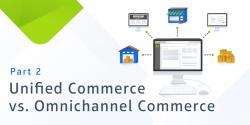Unified Commerce part 2: Unified Commerce vs. Omnichannel

This blog is the second blog in a series about Unified Commerce. Curious about what Unified Commerce is? Check our previous blog.
The rise of new sales channels and customer expectations causes for new ideas about how commerce should be conducted. We’ve seen many strategies arise over the past years. Omnichannel became an important strategy for merchants who sell on multiple sales channels. However, lately, Unified Commerce is said to be the new « holy grail » in selling on multiple channels. Let’s take a look at Unified Commerce vs. Omnichannel Commerce!
Singlechannel, Multichannel, and Omnichannel Commerce
Before we can explain the differences between omnichannel and Unified Commerce, it’s good to know about the historical timeline of where these terms originate from.
Singlechannel
It started with singlechannel commerce. This term relates to retailers who sell their products through one channel, such as a brick-and-mortar store or online webshop. Nowadays, there still are many singlechannel retailers. The term singlechannel commerce was coined together with the term multichannel commerce (early 2000’s).
Multichannel
Multichannel commerce means selling through multiple sales channels. The most common combination of multichannel is a physical store with a webshop. In multichannel, these channels function independently and not coordinated with each other. For example, the webshop can use different prices, delivery terms or delivery times than the store.
Broadly speaking, the commerce world is still divided between singlechannel and multichannel retailers. However, as commerce advanced, so did the strategies that went with it. Especially in multichannel commerce, new strategies were developed.
Nowadays, a term that is often mentioned when talking about selling via multiple sales channels is omnichannel commerce (coined around 2013).
What is Omnichannel?
The omnichannel concept does not only recognize the range of sales channels available, but also considers interactions that consumers may have before, during, and after purchase. In short, omnichannel commerce is a sales strategy that focuses on providing a seamless customer experience through multiple sales channels. It is meant for customers that use multiple channels to engage with a brand before making a purchase.
So far, this sounds much like the definition of Unified Commerce as described in the previous blog:
« Unified Commerce means that regardless of the journey the customer has taken, or what touchpoints they’ve used to make a purchase, their customer experience should remain the same: frictionless. »
(Omnichannel businesses see many benefits of their strategy, read this report by Forrester to find out more).
However, an important difference is that omnichannel does not take back-office processes into consideration. In omnichannel, back-office processes are usually managed in multiple different platforms or tools. The segmented management of channels causes multiple disadvantages for omnichannel merchants.
The Limitations of Omnichannel
Many retailers use a patchwork of business applications to cater to their customer’s omnichannel needs. Point-of-sale (POS), Customer Relationship Management (CRM), Enterprise Resource Planning (ERP), Inventory Management software and Order Management software are just a few examples. Often, custom integrations are made between these systems, in an attempt to get an insight into all back-office processes. In practice, this means that businesses are left with a maze of integrations that cannot truly communicate. Consequently, the systems are unable to deliver the personalized and omnichannel experience that customers are looking for.
Also, these custom integrations often cost businesses a lot of time and money to maintain.
To deliver a true omnichannel experience, merchants need their applications to give them the ability to organize all back-office processes, analyze them and transform them into meaningful insights. In other words, to reach the omnichannel experience that customers are looking for, merchants must abandon the disconnected business applications that they are currently using and look for better-integrated systems.
This is where Unified Commerce steps in.
Unified Commerce vs. Omnichannel
The Unified Commerce strategy gained popularity around 2016 and can be viewed as an all grown-up and matured version of omnichannel. Similar to omnichannel, Unified Commerce focuses on frictionless customer experiences. Where omnichannel mainly focuses on the consumer in the front end – Unified Commerce also focuses on frictionless back end processes for the merchant.
« Delivering real omnichannel experiences is a back-end challenge, not a front-end challenge. » Source: Chain Store Age
True Unified Commerce brings back-office processes, that were previously present in various systems, to a central platform in which each process surrounding the customer experience can be managed.

In Short….
When we look at Unified Commerce vs. Omnichannel, they are in fact are not that far apart. Both try to give the customer the best buying experience possible.
The main difference between omnichannel strategies and Unified Commerce strategies lies in backend strategies. Where omnichannel often consist out of commerce management in different platforms, Unified Commerce seeks to consolidate data and bring together processes in one platform. In short, retailers using Unified Commerce having a single view of customers and business processes that they use to deliver omnichannel experiences.
Now you know the difference of Omnichannel vs. Unified Commerce. But what are the benefits of Unified Commerce? We will answer that question in our next blog ‘The Benefits of Unified Commerce’. Want to be the first one to know when the blog is published? Subscribe to our newsletter or follow us on social media.
Retour au blog